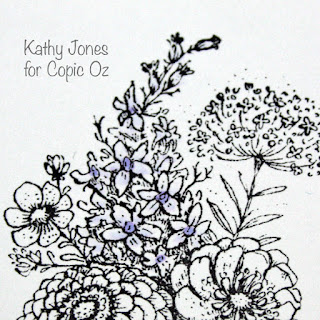Hello Everyone!! I hope you all had a wonderful Christmas (and maybe even received a little Copic goodness from Santa!) and are looking forward to a colourful 2013!! Today I've got a tutorial about the Colourless Blender!!! The magic '0' marker has so many applications that I can't possibly show them all in one tutorial, but I hope you enjoy a couple of ideas (and a couple of extra non-Copic ones too!!).
Today I'm using a stamp set called Garden Picks by Flourishes and I thought I'd use those tiny blossoms as a basis for my Fade To White technique. I'm sure many of you are familiar with the Tip to Tip or Palette technique where you add a dark colour to a light coloured marker and it changes from one colour to the other. Well this is a take on that idea.
I've scribbled a little BV02 onto some acetate and then used my Colourless Blender to pick the colour up - you'll see the BV02 on the end.
Apply to your image. The colour will be darker where you start and fade to white as the Colourless Blender doesn't have any colour. This is perfect for when you are colouring flowers like frangipanis that yellow or pink in the centres and white on the edges.
I've dotted the BV02 in the centres and you can see how the petals are lighter at the ends. You can make the colours as light or dark as you like and continue to apply until you are happy with the finished result.
IMPORTANT - make sure you scribble off any excess colour on your blender!! If you don't, the colour will seep down into the reservoir and then your Blender will no longer be colourless!
The Colourless Blender is also fabulous when you want to lighten your base colour, or you are colouring a large area but want to make sure you don't get any streaking! In this case, I've 'coloured or primed' the water area of the jar with the Colourless Blender.
I've then flicked in some B000 from each side of the jar.
I've then coloured over the middle of the jar again with the Colourless Blender, which will lighten the middle, push the blue more to the edges giving the effect of translucent water!
A little extra tip for you! I wanted to close in the jar top around the flowers (this set has 3 mix and match flowers for the jar), so I've used the 0.1 Black Multiliner and drawn in the edge - no-one would ever know!! ;-)
Now, this would probably be the most used applications for the Colourless Blender! Fixing Mistakes!! As you can see I've gone outside the lines with my Y21 marker, which doesn't look so great.
Take your Colourless Blender and place it BEHIND the colour you want to correct. This is because you are using the Blender to MOVE the colour, not erase it. I'm a country girl, so I think of it like herding cattle inside a gate, the blender is the cattle dog and you use it to push the colour inside the line! :) You can use either the brush end or the chisel end, it's your preference.
Hey presto - the colour is back inside the petal!! Now a word of warning - this doesn't work with reds or very dark colours! Those are stubborn and are more likely to move into the area that you've dampened with your blender instead of the other direction making quite a mess!
Another great tip for when you are doing water - use the X-press It Clear Gel Glue to go over your finished work! (Don't ever colour onto the glue, this is the last step.) The Clear Gel Glue will give your water dimension and shimmer......just don't forget to let it dry really well!! You can also use your blender to create pebbles under your jar - you can find that tutorial HERE.
Finish creating your card!!
Copic Colours used today......
Hyacinths - BV02, Blender, N1 (shadow areas)
Small Blossom - R000, R12, R14
Zinnia - RV000, RV32, RV34, E51, E53, E55
Yellow Flower - Y21, Y35, Y38, YR16, YR18, E55
White Blossom - E51
'Glow' - BG0000
Pebbles - N1, Y21, G82
Stems - G40, G43, G46, G82, G85
Thanks for popping by and I hope you've enjoyed today's tutorial!! Why not have a go at some of these techniques and tips and leave a link in the comments below! We'd love to see what you create!!
Happy Colouring!
Kathy
Pin It














Thanks for the tutorial :)
ReplyDeleteI use the acetate technique often. I also find that laying down a layer of colourless blender first helps a great deal when blending colours that are not very close together.
I used both of those techniques on this pineapple illustration, especially on the leaves where I was blending greens, yellow greens, browns and yellows. http://www.genushumanusalice.com/images/pineapple.jpg
I do wish I'd worked on better quality paper though as the thin bleed proof paper gets damaged so easily.
Alice, your pineapple is FABULOUS!!! Wonderful colouring and the shadows in your leaves are beautifully done!! Thanks for leaving a link for us to see!!! :)
DeleteFantastic tutorial!!! Thanks so much for sharing your wonderful talents.
ReplyDeleteGreat tutorial, Kathy! You've certainly proved that the colourless blender is the ultimate "magic marker".
ReplyDeleteNice job with the very versatile and equally as fabulous CB Kathy, life wouldn't be the same without it!
ReplyDeleteGreat tutorial Kathy, I love your tips for colouring the glass!
ReplyDeleteLoved this tutorial. I have so much to learn!!
ReplyDelete